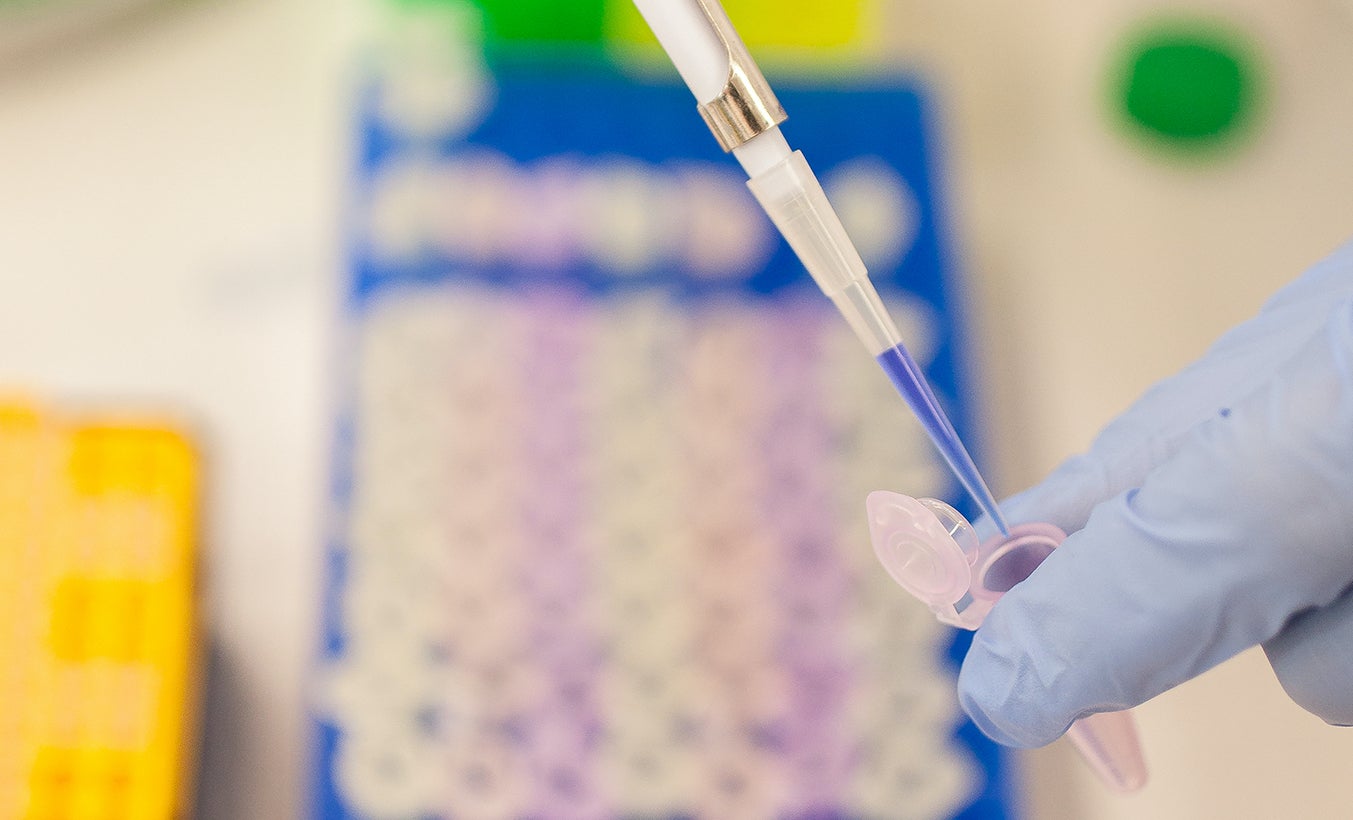The College of Pharmacy continues to expand and strengthen its research community and activities with external funding. This past year represents another successful campaign for COP researchers as they continue to build on their research endeavors.
To recognize the successes of our faculty scholars and researchers and further encourage collaborations at the University and with outside partners, the COP Research Committee has compiled the list of research awards for the period of July 2019-June 2020. Please join us in applauding their efforts so far and wishing them success in their research goals.
 Jessica Alber
Jessica Alber
- RI – Using an Alzheimer’s Disease Blood Test to Predict Amyloid PET in ApoE e4 Non-Carriers (August 2019, Brown University, $42,632). The main goal of this project is to determine the incremental utility of a proteomic/metabolic blood biomarker panel in predicting amyloid PET positivity in cognitively normal older adults, with an emphasis on APOE E4 non’carriers.
- RI – Building an Infrastructure and Dynamic Dataset for AD Risk Assessment (May 2019, Brown University, $8,754). The major goals of study are to build a multi-disciplinary team with biostatistics, biomedical informatics, neuropsychology, and neuroscience expertise, to develop a sustainable, collaborative database of AD risk markers, and to generate a risk algorithm that will identify individuals at early risk for AD using machine learning technique.
 Jessica Alber and Peter Snyder
Jessica Alber and Peter Snyder
- Atlas of Retinal Imaging in Alzheimer’s Study (ARIAS) (January 2019, Morton Plant Hospital Assoc.,Inc., $550,990).
The major goals of this multi-site clinical trial are to develop a dynamic dataset and 3D atlas of longitudinal retinal biomarker changes across the cognitive aging
spectrum.
 Matt Bertin
Matt Bertin
- Determining biotic and abiotic drivers of domoic acid production by Pseudo-nitzschia strains in Narragansett Bay (February 2020, RI Sea Grant., $124,994). The overarching goal of this research project is to identify biotic and abiotic drivers of Pseudo- nitzchia bloom formation and domoic acid production from strains of diatoms that persist in Narragansett Bay. Additionally, we will provide temporal and spatial resolution with respect to Pseudo-nitzschia blooms and domoic acid events in Narragansett Bay.
 Jeffrey Bratberg
Jeffrey Bratberg
- Intervention to Increase Naloxone Engagement and Distribution in Community Pharmacies” A Four-State Randomized Trial” (December 2019, Brandeis University, $37,739). The RESPOND TO PREVENT program provides training, resources, and tools to improve the quality and success rate of naloxone offers by community pharmacists. Through provided scripting, communication guidelines, and patient education, pharmacists can enhance patients’ receptivity and decrease stigma associated with harm reduction practices.
 Ashley Buchanan
Ashley Buchanan
- Causal Inference Methods for HIV Prevention Studies Among Networks of People Who Use Drugs (July 2019, National Institutes of Health, $406,875). Public health studies aimed at earlier HIV treatment have made progress towards reducing HIV incidence not only for those directly-treated drug users but also their risk networks; however, research-to-date has been impeded due to a lack of methods to estimate how interventions permeate a risk network. We propose to develop causal statistical inference methods combined in novel ways with network science applicable in settings with social influence.
- Causal Inference Methods for HIV Prevention Studies Among Networks of People Who Use Drugs (Diversity Supplement) (July 2019, National Institutes of Health, $247,359). The research proposed in this supplement aligns with the methodological goals of the parent project, specifically, a better understanding of direct and disseminated effects of HIV prevention interventions leveraging data from cluster-randomized trials and respondent-driven samples. The objective of this application is to ensure that the causal inference statistical methodology developed in the parent award is applicable to contemporary studies and the results are utilized by the scientific community to improve the treatment and prevention of HIV and HCV among people who use drugs.
 Richard Clements
Richard Clements
- Surgical Cardioprotection Through BKCa-Dependent Modulation of Mitochondrial Supercomplexes (May 2020, National Institutes of Health, $215,199). There is considerable evidence that activation of a cardiac potassium channel, the BKCa channel, may improve heart health and contraction during reduced heart blood flow (ischemia) or heart attacks (myocardial infarction). The purpose of this grant is to determine the mechanism and therapeutic potential of channel activation after ischemic injury associated with heart surgery. Specific focus will be on effects that may alter cardiac energy production.
 Xinjuan Chen
Xinjuan Chen
- A Novel Adjuvant to Boost Influenza Vaccination (May 2019, National Institute of Health, $410,303).
This project develops a physical radiofrequency-based adjuvant with potent humoral and cellular adjuvant effects to boost influenza vaccination with minimal local, systemic or long-term side effects.
 Clinton Chichester and Amanda Chichester
Clinton Chichester and Amanda Chichester
- Validation of Operational Parameters of Non-Invasive Ventilator Designs on a Lung Simulator (May 2020, RI Commerce Corporation, $49,950). This project’s goal is to use the TestChest pulmonary simulator located in the College of Pharmacy’s simulation laboratory to validate ventilation circuits that are made with low-cost respiratory components to provide ventilator treatment for COVID patients. At the end of the project, we expect to have well-characterized patient circuits for noninvasive ventilation treatment options that will be distributed around the world to various governments, NGOs and hospitals.
 Bongsup Cho
Bongsup Cho
- Rhode Island IDeA Network for Excellence in Biomedical Research, (May 2020, National Institutes of Health, $4,047,778). RI-INBRE is a NIH-sponsored state-wide program grant and its major objective is to support and develop talented individuals, committed to research careers in Rhode Island, and to build the biomedical research capacity of Rhode Island higher education institutions.
Ruitang Deng
- Interplay of Bile Acid and Estrogen Signaling (January 2020, National Institutes of
 Health, $343,436). Hepatocellular carcinoma (HCC) is the sixth most common cancer worldwide and the third leading cause of cancer-related deaths. At present, there are limited options in treating HCC patients. This multi-year R01 grant is aimed at understanding the underlying mechanisms by which HCC develops through the dysregulation of the bile acids/ farnesoid X receptor (FXR) and estrogens/estrogen receptor alpha signaling pathways.
Health, $343,436). Hepatocellular carcinoma (HCC) is the sixth most common cancer worldwide and the third leading cause of cancer-related deaths. At present, there are limited options in treating HCC patients. This multi-year R01 grant is aimed at understanding the underlying mechanisms by which HCC develops through the dysregulation of the bile acids/ farnesoid X receptor (FXR) and estrogens/estrogen receptor alpha signaling pathways. - Interplay of Bile Acid and Estrogen Signaling (Diversity Supplement) (March 2020, National Institutes of Health, $80,087). USP2 expression was dysregulated in FXR knockout (FXR-KO) and ERa-KO mice and correlated with HCC phenotypes in the knockout mice. There are two isoforms of USP2 in the liver, including USP2a and USP2b. This supplement grant is to test the hypothesis that FXR and ERalpha signaling exert their effects on the pathogenesis of HCC through differentially regulating USP2a and USP2b.
 Claudia Fellini
Claudia Fellini
- Mechanisms of actin-dependent regulation of nuclear pores in postmitotic neurons (May 2020, RI-INBRE Early Career Development Award, $70,000). This grant aims at elucidating the mechanisms linking actin and the regulation of nucleocytoplasmic transport in ALS using human iPSC-derived neurons. Results obtained through this research will broaden our understanding of the cellular and molecular mechanisms leading to neurodegeneration in ALS, and possibly inform novel pathways to target for therapeutic development.
- Investigating Cellular Mechanisms of Neurodegeneration in ALS (June 2020, Roddy Foundation, $96,482). This grant sponsored the purchase of capital equipment to expand lab research possibilities. Through the support of this grant, we will acquire state of the art equipment to perform longitudinal imaging of iPSC-derived neurons to investigate disease mechanisms and screen novel compounds to target cellular pathology associated with neurodegeneration in ALS.
 Nisanne Ghonem
Nisanne Ghonem
- Evaluation of the Preliminary Safety and Efficacy of Treprostinil (Remodulin) in Reducing Ischemia-Reperfusion Injury During De Novo Adult Kidney Transplantation (July 2019, Rhode Island Hospital, $302,716). A single-center, open-label, Phase I/II dose-escalation study to determine the preliminary safety and efficacy of treprostinil in reducing I/R injury associated with adult de novo kidney transplantation.
 Dennis Hilliard
Dennis Hilliard
- Edward Byrne Justice Assistance Grant (Byrne/JAG) Sub-Grant Laboratory Improvement (December 2019, RI Department of Public Safety, $17,793). These funds were used in the creation of five (5) rooms within Fogarty 009, to provide space for use in the BPS 101 and 102 courses, as crime scene area rooms. These rooms are used for practical exercises for the law enforcement officers who attend the two-semester course: Criminal Investigations: Scientific Evidence I & II. The rooms greatly benefit the educational component of the State Crime Laboratory in conjunction with the University and the College of Pharmacy.
- Coverdell Crime Laboratory Improvement Grant FY19 (April 2020, RI Department of Public Safety, $61,262). The RISCL has experienced an increase in requests for Primer Gun Shot Residue (pGSR) analysis. However, the RISCL does not have the use of a Scanning Electron Microscope (SEM) with elemental x-ray detection (EDAX) for the detection of pGSR on a suspected shooter’s hands or other objects. This evidence must be sent to a secondary Laboratory for testing when the evidence is needed for a court proceeding. The RISCL is seeking funding to purchase a SEM that will allow this evidence and other types of evidence to be analyzed “in-house” to avoid the continual reliance on the use of a secondary laboratory and to eliminate the extra requirements of maintaining “Chain of Custody” between laboratories. These funds combined with other funding resources were used to purchase and install a Scanning Electron Microscope.
 Anne Hume, Erica Estus and Christine Eisenhower
Anne Hume, Erica Estus and Christine Eisenhower
- RI Geriatrics Workforce Enhancement Program (July 2019, US Dep of Health & Human Srvcs, $113,500). The Rhode Island Geriatrics Workforce Enhancement Program (RI-GWEP) focuses on educating primary care providers and health professions trainees in the core principles of geriatrics. Interprofessional teamwork and collaborative practice in caring for older adults is a major focus of the project.
 Anita Jacobson
Anita Jacobson
- IIHI Community First Provider Program – SAMHSA ROTA Program (September 2019, Substance Abuse & Mental Health Services, $604,565). The Community First Responder Program is a collaboration between the College of Pharmacy, College of Nursing and Cooperative Extension to offer opioid use disorder education and overdose prevention to rural communities. Specifically, the program will offer educational modules for healthcare professionals and the public on the Cooperative Extension website and host outreach events and educational seminars with naloxone distribution in rural communities across Rhode Island.
- Rhode Island Developmental Disabilities Council – RIDDC FY 2019 (September 2019, US Department of Health and Human Services, $520,325). The Developmental Disabilities Act provides for a formula grant to provide comprehensive planning for people with developmental disabilities, develop a State Plan, and implement selected activities contained in the State Plan. The Act requires that the Council be attached to a State Agency to provide very specific support functions to support the Council, The University of Rhode Island is that state agency under RIGL40.1-1-9.
 Stephen Kogut
Stephen Kogut
- Institutional Development Award (IDeA) Program Infrastructure for Clinical and Translational Research (May 2020, Brown University, $202,575). This program is a statewide consortium of universities, hospital systems and non-profit agencies that provides the infrastructure to support, train and educate investigators conducting clinical and translational research. Dr. Kogut is directing the team responsible for the tracking and evaluation of program outcomes.
- Opioids COBRE Pilot Project: Buprenorphine With Additional Rx Exposure (B-WARE) (June 2020, The Lifespan COBRE on Opioids and Overdose, $37,246). This pilot project utilizes data from the RI Prescription Drug Management Program to evaluate treatment adherence patterns with buprenorphine for opioid use disorder, overall and among patients concurrently utilizing other controlled medications.
- Empowering the Safe, Effective and Efficient Use of Medications in Older Adults (December 2019, United Healthcare / Care Transformation Collaborative of RI, $50,000). This project utilizes data from the RI All Payer Claims Dataset to measure a range of pharmacy-related performance measures addressing the safety, effectiveness and efficiency of medication use among older adults. The measures are being applied to inform local systems of care in their efforts to improve prescribing.
 Kerry LaPlante
Kerry LaPlante
- COBRE Center for Antimicrobial Resistance and Therapeutic Discovery (August 2019, The Miriam Hospital, $15,522). The principal objective of this COBRE application is to build a unique, multi-disciplinary center of excellence to study mechanisms of antimicrobial resistance and develop therapeutic countermeasures. The long-term goal of the Center for Antimicrobial Resistance and Therapeutic Discovery (CARTD) at The Miriam Hospital of the Lifespan Hospital Group is to develop new therapies for infections caused by drug resistant pathogens. Dr. LaPlante is Directory of the pharmacology CORE in the CARTD by providing advice on pharmacodynamics, pharmacokinetics and other pharmacology considerations related to drug development.
- Development and Risk Assessment for Fully Weight-Bearing Antibiotic-Eluting Joint Implants (April 2020, Massachusetts General Hospital, $32,044). The long-term goal is to use local release of therapeutics to treat orthopaedic conditions. The goal of this application is to devise an antibiotic-eluting and load-bearing joint implant platform technology for the treatment of PJI. Dr. LaPlante will characterize bacterial populations proposed in the study and provide necessary in-vitro bacterial characterization studies based on identified “high risk” and “low risk” strains from library of Staphylococcus aureus and Staphylococcus epidermidis library of clinical strains.
- Improving Antimicrobial Stewardship in Veterans Affairs (VA) Community Living Centers (May 2020, Providence Veterans Affairs Medical Center, $36,134). The overall goals of this four-year mixed methods MERIT proposal are to determine the scope of antimicrobial resistance among VA CLCs, to compare that information with antimicrobial utilization patterns in CLCs and their affiliated VAMCs, and to develop effective AMS strategies for VA CLCs. The long-term goals of this study are to improve antibiotic use, decrease resistance and improve patient care and safety at VA CLCs nationally.
 Kerry LaPlante and Aisling Caffrey
Kerry LaPlante and Aisling Caffrey
- Utilization and Treatment Outcomes with Ceftolozane/tazobactam in the National Veterans Affairs Healthcare System (May 2020, Ocean State Research Institute, Inc, $57,337). To describe utilization and outcomes of ceftolozane/tazobactam in the national VA Healthcare System, to enumerate cohorts with similar microbiological findings and identify antibiotic exposures in these groups through exposure mapping.
- Antibiotic Resistance Rates and Treatment of Acinetobacter Baumanii and Stenotrophomonas in National VA Healthcare System (June 2020, Ocean State Research Institute, Inc, $13,989). To describe antibiotic resistance rates among Acinetobacter baumannii and Stenotrophomonas maltophilia positive clinical cultures collected in the national Veterans Affairs Healthcare System and describe antibiotic treatment patterns during hospitalizations for infections caused by Acinetobacter baumannii and Stenotrophomonas maltophilia.
 Deyu Li
Deyu Li
- Mutational Spectra of Bulky DNA Lesions (January 2020, National Institute of Health $426,504). Many aromatic amines are environmental toxins and human carcinogens. They damage the genome and form different bulky DNA lesions, which give rise to different mutation patterns. This application will study the mutational spectra of bulky DNA lesions generated from aromatic amine exposure and provide insights into the development of tumors.
 Rita Marcoux and Lisa Cohen
Rita Marcoux and Lisa Cohen
- Pharmacy Program Oversight/Utilization Review (December 2020, RI Department of Corrections, $175,850). This grant involves providing clinical services and oversight of pharmaceutical purchasing for the Department of Corrections – Rhode Island. This includes development of pharmacy policies and procedures, management reporting, quality assurance, clinical and formulary services, and oversight of medication administration, storage and inventory and the computerized pharmacy order entry system and clinical rotation and training projects for pharmacy students.
 Jyothi Menon
Jyothi Menon
- MRI: Acquisition of a Scanning/Transmission Electron Microscope for Materials Research and Education (September 2019, National Science Foundation, $322,000). The NSF-MRI is a Major Research Instrumentation grant, and the funds will be used to purchase a state-of-the-art 200kV field emission scanning transmission electron microscope (S/TEM), with Energy Dispersive Spectroscopy (EDS) and Electron Energy Loss Spectroscopy (EELS) detectors, along with a Direct Electron Camera (DEC), This instrument will support research in the areas of Nanomedicine, Environmental Science and Engineering, Biotechnology and Structural Biology, Energy Materials, and Materials Dynamics at the Nanoscale at URI.
 Katharina Quinlan
Katharina Quinlan
- Impairment of Spinal Development in Cerebral Palsy (July 2019, National Institutes of Health, $306,320). In this project, the Quinlan lab is exploring the potential to treat cerebral palsy through modulation of neural networks in the spinal cord. These networks are disrupted during development by the injuries that cause the condition. Finding aberrations in the behavior of spinal neurons may provide a more direct pathway to remedy associated motor dysfunction. Parallel, longitudinal studies will quantify timing and development of abnormalities in spinal circuits in children with cerebral palsy and in a rabbit model where we can more directly investigate altered properties spinal neurons and neuronal circuits.
- TRPV4 links the blood-neural barrier to motor neuron dysfunction (April 2020, National Institute of Health, The John Hopkins University, $71,657). Increased permeability of blood-neural barriers (BNBs) has been implicated in the pathogenesis of multiple acute and chronic neurological disorders, including neurodegenerative disease, but the specific contributions of BNB impairments to neuronal dysfunction and degeneration have been difficult to pinpoint. This study will address autosomal dominant mutations of the cell surface-expressed cation channel transient receptor potential vanilloid 4 (TRPV4), which causes subtypes of spinal muscular atrophy and Charcot-Marie-Tooth disease. The Quinlan lab will characterize the effect of this mutation on the activity of spinal motoneurons which are functionally impaired in a mouse model of the disorder, and investigate whether a TRPV4 small molecule antagonist could be a novel treatment to restore function in these mice and those with other neurological diseases characterized by impaired BNBs.
 Katharina Quinlan and Nasser Zawia
Katharina Quinlan and Nasser Zawia
- Impairment of Spinal Development in Cerebral Palsy – Supplement (August 2019, National Institutes of Health, $376,565). This project aims to develop a more clinically relevant model of Alzheimer’s and related dementia (ADRD) that is based on the multiple hit theory of neurodegeneration, in which multiple stressors on the nervous system contribute to risk of developing ADRD. This proposal uses rabbits with developmental hypoxia ischemia injuries on a poor diet (high cholesterol with trace Cu after weaning) which is known to induce Alzheimer’s in rabbit models. This diet and injury rabbit model of ADRD could be useful in testing therapeutics in an animal model that more accurately reflects the multifactorial causes of ADRD in our human population.
 Kathryn Ramsey
Kathryn Ramsey
- Investigating specialized ribosomes and gene regulation in Francisella tularensis (May 2020, RI-INBRE, $99,384). Vectorborne and zoonotic diseases are an ongoing and increasing public health threat in the United States. The proposed work will improve our fundamental knowledge of tickborne disease and potentially reveal novel targets for antimicrobial drug development.
 David Rowley
David Rowley
- Molecular Mechanisms of Interspecies Interactions in Mitigating Aquaculture Diseases (July 2019, U.S. Department of Agriculture, $141,036). The long-term goal of this project is to develop commercial tools to reduce disease burdens in shellfish aquaculture. This project will test the hypothesis that specific molecular mechanisms are employed by hosts, probionts, and pathogens that determine the outcomes of interspecies interactions and, ultimately, the health and survival of the host. In particular, we will probe the role of bacterial type VI secretion systems (T6SS) in determining the interaction outcomes between probiotic bacteria and pathogens.
- Aquaculture: Modifying Microbiomes to Mitigate Infectious Diseases in Aquaculture Facilities (September 2019, U.S. Department of Agriculture, $99,000). There is an unmet need for novel tools to prevent and treat disease outbreaks at aquaculture facilities. Using in vivo infection models and hatchery studies, our probiotic bacterium, Phaeobacter inhibens S4, has demonstrated host protection for shellfish larvae against problematic bacteria pathogens. In this project, we test the hypothesis that this probiotic activity is the result of multiple contributing factors, including beneficial alteration to the host microbiome that results in improved host resistance to infection. This research will lead to improved knowledge of probiont-pathogen-host-environmental interactions, knowledge that can be used to optimize the use of probiotics in hatcheries.
 Navindra Seeram
Navindra Seeram
- Physicochemical Characterization and Biological Evaluations of Cannabidiol (CBD) and its Formulation (January 2020, URI Research Foundation, $154,369). Cannabidiol (CBD), the major non-psychoactive phytocannabinoid in Cannabis, and its formulation products, are being extensively used for topical applications for dermatological and/or cosmetic purposes. However, it remains a challenge to develop suitable CBD-based formulations due to the lack of studies on their stability in different environments. This project will characterize the physicochemical properties of CBD and its formulations for the development of quality research-based CBD dermatological products.
 Jie Shen
Jie Shen
- Bioequivalence Considerations of Topical Rectal and Vaginal Products (September 2019, Food and Drug Administration, $250,000). The major goal of this project is to develop comparative product characterization-based bioequivalence approaches that are suitable for topical rectal and vaginal drug products, and to help advance regulatory review and approval processes for these products.
- A Continuous Manufacturing Platform for Complex Dosage Forms (September 2019, University of Connecticut STORRS, $432,827). The major goal of this project is to build and test a continuous manufacturing platform with modular components for complex dosage forms such as liposomes for use in a cGMP facility.
 Angela Slitt
Angela Slitt
- CI – STEEP – Sources, Transport, Exposure and Effects of Perfluoroalkyl Substances (April 2020, National Institutes of Health, $197,953). The major goal of the multi-million-dollar grant for NIEHS Superfund Research Program (P42) is to address the emerging and expanding problem of poly- and per-fluorinated alkyl substances (PFASs) contamination. Dr. Slitt is the leader of Project 3 — evaluation of PFAS exposure as a risk for obesity-induced dysregulation of hepatic and adipose tissue function.
- CI – STEEP – Sources, Transport, Exposure and Effects of Perfluoroalkyl Substances – Training Core (April 2020, National Institutes of Health, $92,281). A goal of the multi-million-dollar grant for NIEHS Superfund Research Program (P42) is to train the next generation of environmental health scientists in the area of emerging contaminants. Through STEEP SRP, The University of Rhode Island and Harvard University provide a rich interdisciplinary training program to graduate students and postdoctoral fellows who are funded through the STEEP SRP Center. Dr. Slitt (URI) and Dr. Sunderland (Harvard) are co-leaders of the STEEP SRP training core.
 Lynn Taylor
Lynn Taylor
- IIHI – Patient Centered Models of Hepatitis C Care for People Who Inject Drugs (February 2020, PCORI (Clemson University-Prisma Health), $268,936). The purpose of this pragmatic randomized, 8-site, national trial is to determine the optimal approaches for treating hepatitis C virus infection (HCV) in people who inject drugs at methadone programs and community health centers. We test the effectiveness of patient navigation vs. modified directly observed therapy on HCV treatment initiation, adherence (measured by electronic packs), completion, and sustained virologic response, as well as reinfection.
 William Van Nostrand
William Van Nostrand
- Understanding the Origins of Amyloid Deposition in Cerebral Amyloid Angiopathy (April 2020, National Institutes of Health, $383,750). Recent work from our laboratory has indicated that the structure of amyloid fibrils that accumulate in cerebral blood vessels, a condition known as cerebral amyloid angiopathy (CAA), is different than amyloid fibrils that accumulate in brain parenchymal plaques. The major goal of this project is to elucidate the novel structural features of amyloid deposition in CAA using in vitro and transgenic mouse approaches.
- The Role of Copper in Cerebral Amyloid Angiopathy Year 5 (May 2020, National Institutes of Health, $383,750). We have recently found that the amyloid deposits that accumulate in cerebral blood vessels harbor elevated amounts of copper. The major goal of this project is to determine whether there is a structural basis for the accumulation of copper in the vascular amyloid associated with cerebral amyloid angiopathy (CAA) and how copper influences the formation of CAA and pathologies associated with this condition using transgenic rodent models.
- Cerebral Amyloid Angiopathy Fluid Biomarkers Evaluation (CAFE) (June 2020, National Institutes of Health, $643,743). This project focuses on the development of novel biological fluid markers for the condition known as cerebral amyloid angiopathy (CAA), which is the accumulation of amyloid in blood vessels of the brain. Here we take a complementary approach utilizing cerebrospinal fluid and blood samples obtained from CAA patients and novel animal models of CAA for discovery of CAA biomarkers.
- Structural Identification and Functional Consequences of Different Amyloid Strains in Alzheimer’s Disease (June 2020, The Research Foundation for SUNY, $303,427). Alzheimer’s disease presents with different clinical subtypes that have different somewhat different pathological features. In particular, subtypes of Alzheimer’s disease can exhibit neuronal plaques with different types of morphology that may contribute to their different forms of clinical presentation. The major goals of this project are to identify distinct structural features of amyloid from different subtypes of AD and to study their unique functions in promoting neuroinflammation.
- Efficacy of siRNA to prevent cerebral amyloid Angiopathy in rTg-DI Transgenic Rats (March 2020, Alnylam Pharmaceuticals, $178,264). Currently, there are no effective therapies to treat cerebral amyloid angiopathy, a condition that involves accumulation of amyloid in brain blood vessels that can lead to restricted cerebral blood flow, stroke, hemorrhage and cognitive decline. We have generated transgenic rats that develop cerebral amyloid angiopathy and are a useful preclinical model to test new potential therapies to treat this condition. The goal of the project is to test a new promising therapeutic intervention for cerebral amyloid angiopathy in this model.
 Ami Vyas
Ami Vyas
- Use of Rhode Island-All Payer Claims Database to Evaluate Rhode Island Women’s Breast Cancer Screening Compliance and Impact on Breast Cancer Diagnosis (November 2019, RI Department of Health, $33,000). The purpose of this study is to evaluate mammography screening use in women who obtained their prior screenings at the women’s breast cancer screening program. We will also examine the association between compliance with mammography screening and the stage at breast cancer diagnosis among women in Rhode Island.
- Are We “Choosing Wisely” And Improving Value in Cancer Care? (June 2020, Advance-CTR, $57,933). The purpose of the study is to examine the effect of the ASCO-defined Choosing Wisely campaign to identify the extent of low-value cancer care in elderly patients with breast or prostate cancer. We will also identify the predictors of low-value cancer care in these patients.
 Xuerong Wen
Xuerong Wen
- Neonatal Neurodevelopment and Maternal Outcomes in Pregnancy with Opioid Exposure (February 2020, National Institute of Health, $435,491). The rapid increase in the incidence of opioid-related overdoses and deaths has become a major public health threat in the United States. This project focuses on the relationship between perinatal opioid exposure and adverse health outcomes in mothers and children. Our results will help determine the role of perinatal opioid exposures on children development and provide evidence for improved perinatal care.

